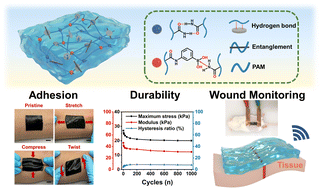Nanocomposite conductive hydrogels with Robust elasticity and multifunctional responsiveness for flexible sensing and wound monitoring†
Abstract
Flexible biosensors made from conductive hydrogels have shown tremendous potential in health management and human–machine interfaces. Nevertheless, it remains challenging to fabricate conductive hydrogels with robust resilience and long-term stability. Herein, we report a nanocomposite conductive hydrogel prepared through one-pot radical polymerization of 3-acrylamidophenylboronic acid (APBA) and acrylamide (AM) in the presence of LAPONITE® XLG nanosheet (XLG) stabilized carbon nanotubes (CNTs). Owing to the existence of various non-covalent interactions within the network (B–N coordination, hydrogen bond, and polymer chain entanglement), the hydrogels feature splendid mechanical properties with a tensile strength of 252–323 kPa, fracture strain of 880–1200%, Young's modulus of 48–50 kPa and fracture energy of 911–1078 J m−2, and exhibit robust elasticity and fatigue resistance during 1000 consecutive tensile and compressive cycles. The hydrogels show remarkable sensing performances (gauge factor up to 9.43) and a broad sensing range of strain (1–300%) and pressure (1–80 kPa), enabling reliable and accurate monitoring of large and tiny motions in daily human life. Moreover, the conductive hydrogels could not only accelerate skin incision healing but also act as smart wearable sensors to monitor the skin wound healing process by detection of local temperature changes.



 Please wait while we load your content...
Please wait while we load your content...